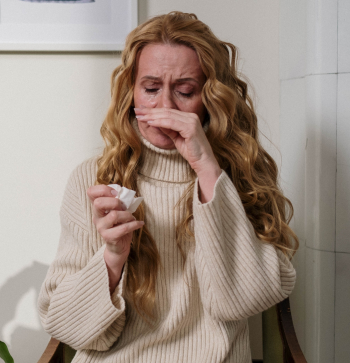 A new allergy study has started at Royal Brompton and Harefield hospitals which will investigate house dust mite and silver birch tree allergies.
A new allergy study has started at Royal Brompton and Harefield hospitals which will investigate house dust mite and silver birch tree allergies.
Led by allergy consultant Dr Guy Scadding, the study involves introducing increasing concentrations of allergens into the nose of allergy suffers, in a procedure known as a nasal allergen challenge.
An allergy is where your body reacts to something that's normally harmless like pollen, dust or animal fur. It is a very common condition which affects approximately 1 in 4 people in the UK and although the symptoms can be mild, in some people they can be very serious and can affect quality of life.
Why house dust mite and silver birch pollen allergies?
House dust mites are microscopic insects which live in the dust in carpets, bedding, furnishing and soft toys, and silver birch is a type of tree which is very common in the UK that produces pollen.
Dr Guy Scadding explained the reason for focusing on these two allergies:
“House dust mite is the most common indoor trigger for allergic respiratory conditions such as rhinitis and asthma. Tree pollen allergy, including silver birch pollen, is an increasingly common cause of hay fever in the spring in the UK.”
The research project
Research has shown that controlled exposure to allergens can provide important information on how the body reacts during an allergic reaction, which may be used to determine the success of anti-allergy treatments.
In this study, the allergy research team will be undertaking nasal allergen challenges in participants by introducing the allergens into the nose at increasing concentrations.
Dr Scadding explained, “We have been using nasal allergen challenges to study the biology of allergic inflammation and the effects of anti-allergy medications for many years. Soluble allergen at defined concentrations is sprayed into the participant’s nose, provoking typical hay fever symptoms within less than a minute.
“We ask the participant to report on their level of itching, nose running and nose blockage, and record how many times they sneeze. We also record how well they can sniff in through their nose using a device called a peak inspiratory flow meter. The procedure is very safe, with no major adverse reactions seen having done close to 1,000 such procedures in the department over the last 15 years.”
What taking part in the study involves, and how to find out more
Participants in the study will be invited to undergo a skin prick test to confirm their allergy, and then given increasing doses of either house dust mite allergen or silver birch pollen allergen, depending on the allergy.
This will allow the team to determine the dose-response to increasing concentrations of these allergens on symptoms and airflow through the nose and identify the optimal single dose to use in future allergy studies.
“We will discover the concentration of each allergen that will produce clear allergic symptoms in the majority of patients with these allergies. This will enable us to use single doses of allergen for nasal challenges in clinical practice and in future research studies assessing the impact of anti-allergy medications.” Dr Scadding said.
If you would like to participate in this study or find out more, please contact research nurse Ana Gil.
Read more of our research stories or sign up to our research newsletter.
